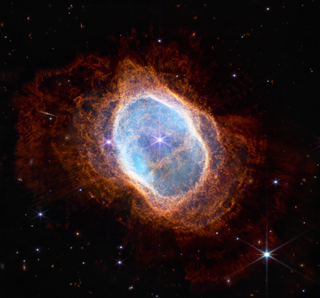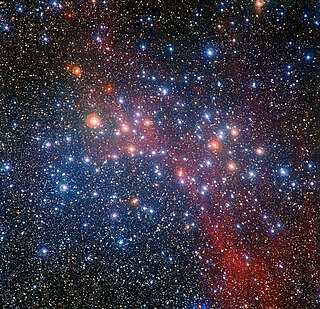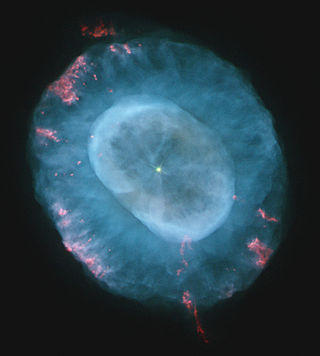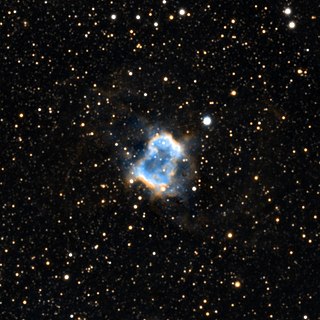
A nebula is a distinct luminescent part of interstellar medium, which can consist of ionized, neutral, or molecular hydrogen and also cosmic dust. Nebulae are often star-forming regions, such as in the Pillars of Creation in the Eagle Nebula. In these regions, the formations of gas, dust, and other materials "clump" together to form denser regions, which attract further matter and eventually become dense enough to form stars. The remaining material is then thought to form planets and other planetary system objects.

A planetary nebula is a type of emission nebula consisting of an expanding, glowing shell of ionized gas ejected from red giant stars late in their lives.

The Ring Nebula is a planetary nebula in the northern constellation of Lyra.[C] Such a nebula is formed when a star, during the last stages of its evolution before becoming a white dwarf, expels a vast luminous envelope of ionized gas into the surrounding interstellar space.

The Orion Nebula is a diffuse nebula situated in the Milky Way, being south of Orion's Belt in the constellation of Orion,[b] and is known as the middle "star" in the "sword" of Orion. It is one of the brightest nebulae and is visible to the naked eye in the night sky with an apparent magnitude of 4.0. It is 1,344 ± 20 light-years (412.1 ± 6.1 pc) away and is the closest region of massive star formation to Earth. The M42 nebula is estimated to be 24 light-years across. It has a mass of about 2,000 times that of the Sun. Older texts frequently refer to the Orion Nebula as the Great Nebula in Orion or the Great Orion Nebula.

An astronomical object, celestial object, stellar object or heavenly body is a naturally occurring physical entity, association, or structure that exists within the observable universe. In astronomy, the terms object and body are often used interchangeably. However, an astronomical body or celestial body is a single, tightly bound, contiguous entity, while an astronomical or celestial object is a complex, less cohesively bound structure, which may consist of multiple bodies or even other objects with substructures.

The Cat's Eye Nebula is a planetary nebula in the northern constellation of Draco, discovered by William Herschel on February 15, 1786. It was the first planetary nebula whose spectrum was investigated by the English amateur astronomer William Huggins, demonstrating that planetary nebulae were gaseous and not stellar in nature. Structurally, the object has had high-resolution images by the Hubble Space Telescope revealing knots, jets, bubbles and complex arcs, being illuminated by the central hot planetary nebula nucleus (PNN). It is a well-studied object that has been observed from radio to X-ray wavelengths. At the centre of the Cat's Eye Nebula is a dying Wolf Rayet star, the sort of which can be seen in the Webb Telescope's image of WR 124. The Cat's Eye Nebula's central star shines at magnitude +11.4. Hubble Space Telescope images show a sort of dart board pattern of concentric rings emanating outwards from the centre.

The Lagoon Nebula is a giant interstellar cloud in the constellation Sagittarius. It is classified as an emission nebula and has an H II region.

The Little Dumbbell Nebula, also known as Messier 76, NGC 650/651, the Barbell Nebula, or the Cork Nebula, is a planetary nebula in the northern constellation of Perseus. It was discovered by Pierre Méchain in 1780 and included in Charles Messier's catalog of comet-like objects as number 76. It was first classified as a planetary nebula in 1918 by the astronomer Heber Doust Curtis. However, others might have previously recognized it as a planetary nebula; for example, William Huggins found its spectrum indicated it was a nebula ; and Isaac Roberts in 1891 suggested that M76 might be similar to the Ring Nebula (M57), as seen instead from the side view.

The Owl Nebula is a planetary nebula approximately 2,030 light years away in the constellation Ursa Major. Estimated to be about 8,000 years old, it is approximately circular in cross-section with a faint internal structure. It was formed from the outflow of material from the stellar wind of the central star as it evolved along the asymptotic giant branch. The nebula is arranged in three concentric shells, with the outermost shell being about 20–30% larger than the inner shell. The owl-like appearance of the nebula is the result of an inner shell that is not circularly symmetric, but instead forms a barrel-like structure aligned at an angle of 45° to the line of sight.

NGC 7027, also known as the Jewel Bug Nebula or the Magic Carpet Nebula, is a very young and dense planetary nebula located around 3,000 light-years from Earth in the constellation Cygnus. Discovered in 1878 by Édouard Stephan using the 800 mm (31 in) reflector at Marseille Observatory, it is one of the smallest planetary nebulae and by far the most extensively studied.

A protoplanetary nebula or preplanetary nebula is an astronomical object which is at the short-lived episode during a star's rapid evolution between the late asymptotic giant branch (LAGB)[a] phase and the subsequent planetary nebula (PN) phase. A PPN emits strongly in infrared radiation, and is a kind of reflection nebula. It is the second-from-the-last high-luminosity evolution phase in the life cycle of intermediate-mass stars.

NGC 3132 is a bright and extensively studied planetary nebula in the constellation Vela. Its distance from Earth is estimated at 613 pc or 2,000 light-years.

NGC 3532, also commonly known as the Pincushion Cluster, Football Cluster, the Black Arrow Cluster, or the Wishing Well Cluster, is an open cluster some 405 parsecs from Earth in the constellation Carina. Its population of approximately 150 stars of 7th magnitude or fainter includes seven red giants and seven white dwarfs. On 20 May 1990 it became the first target ever observed by the Hubble Space Telescope. A line from Beta Crucis through Delta Crucis passes somewhat to the north of NGC 3532. The cluster lies between the constellation Crux and the larger but fainter "False Cross" asterism. The 4th-magnitude Cepheid variable star x Carinae appears near the southeast fringes, but it lies between the Sun and the cluster and is not a member of the cluster.

NGC 2022 is a planetary nebula in the equatorial constellation of Orion, located at a distance of 8.21 kilolight-years from the Sun. It was first observed by William Herschel on December 28, 1785, who described it as: considerably bright, nearly round, like a star with a large diameter, like an ill-defined planetary nebula. In medium-sized amateur telescopes it looks like a small grayish patch of light. It is not very bright but it is still easy to spot it in the eyepiece. Even in a telescope as small as 80mm it can just be seen using a narrowband filter such as an OIII filter as a 'fuzzy' star. The object has the shape of a prolate spheroid with a major to minor axis ratio of 1.2, an apparent size of 28″, and a halo extending out to 40″, which is about the angular diameter of Jupiter as seen from Earth.

NGC 7635, also known as the Bubble Nebula, Sharpless 162, or Caldwell 11, is an H II region emission nebula in the constellation Cassiopeia. It lies close to the open cluster Messier 52. The "bubble" is created by the stellar wind from a massive hot, 8.7 magnitude young central star, SAO 20575 (BD+60°2522). The nebula is near a giant molecular cloud which contains the expansion of the bubble nebula while itself being excited by the hot central star, causing it to glow. It was discovered in November 1787 by William Herschel. The star BD+60°2522 is thought to have a mass of about 44 M☉.

NGC 7662 is a planetary nebula located in the northern constellation Andromeda. It is known as the Blue Snowball Nebula, Snowball Nebula, and Caldwell 22. This nebula was discovered October 6, 1784 by the German-born English astronomer William Herschel. In the New General Catalogue it is described as a "magnificent planetary or annular nebula, very bright, pretty small in angular size, round, blue, variable nucleus". The object has an apparent visual magnitude of 8.3 and spans an angular size of 32″ × 28″. Parallax measurements give a distance estimate of 5,730 ± 340 ly (1,757 ± 103 pc).

NGC 2899 is a planetary nebula in the southern constellation of Vela. It was discovered by English astronomer John Herschel on February 27, 1835. This nebula can be viewed with a moderate-sized amateur telescope, but requires a larger telescope to resolve details. NGC 2899 is located at a distance of 3,350 ± 670 light-years (1,026 ± 205 pc) from the Sun and 25,894 ± 3 light-years (7,939 ± 1 pc) from the Galactic Center.

IRAS 19475+3119 is a protoplanetary nebula in the constellation of Cygnus, 15,000 light-years away. The central star, V2513 Cygni, is an F-type post-AGB star.

NGC 6445, also known as the Little Gem Nebula or Box Nebula, is a planetary nebula in the constellation Sagittarius. It was discovered by William Herschel on May 28, 1786. The distance of NGC 6445 is estimated to be slightly more than 1,000 parsecs based on the parallax measured by Gaia, which was measured at 0.9740±0.3151 mas.

CIT 6 is a carbon star in the constellation Leo Minor. It is a semiregular variable star, with a period of about 628 days, and has been given the variable star designation RW Leonis Minoris. It is perhaps the second most studied carbon star, after CW Leonis. CIT 6 was discovered in 1966 by a group at the California Institute of Technology who found it using the same 62-inch infrared telescope on Mount Wilson that was used to produce the Two-Micron Sky Survey. It is the second brightest carbon star in the near-infrared, after CW Leonis.




















